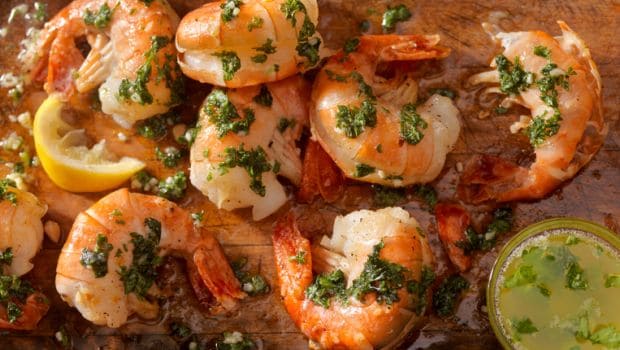Is Shrimp Healthy?

Shrimp has insinuated its way into kitchens around the world. There’s delicately-spiced potted shrimp and creamy retro favourite – shrimp cocktail – for the British. In Brazil, shrimp is stuffed into the bellies of rissoles and pastels, and tossed into stews. Shrimp finds its way into New Orleans’ jambalaya and sits on a bed of creamy grits in South Carolina. In China, tiny dried shrimp that are flake-thin are tossed into sauces and stir fries to pump up the umami flavour. In Spain, little curls of shrimp transform into gambas al ajillo and paella. Closer to home, Kerala produces a delectable shrimp pickle, whereas my Chennai-born friend whips up a vividly-flavoured shrimp kuzhambu, and in Pondicherry I found kadugu yerra, a tangy, coconut shrimp. Meanwhile, in Goa, a friend’s mother married two unusual ingredients – shrimp and okra – to make a glorious dinner dish (and next day, a balcao!).
Parsis make shrimp patio, which is a sort of spicy gravy accompaniment to dal and rice.
That’s just skimming the surface — if I dig deeper, a plethora of shrimp recipes will rise to the surface. Obviously, the world loves shrimp. According to the World Wildlife Organisation, it’s one of the most valuable traded marine products in the world today – around six million tons is consumed annually! Most shrimp farming happens in China, followed by Thailand, Indonesia, India, Vietnam, Brazil, Ecuador and Bangladesh, and is imported by the USA, Europe, Japan etc.
Why eat shrimp?
There’s no doubt that shrimps are a rather healthy choice, in and of itself. For one, they have very high levels of dietary protein. A large part of the edible parts of shrimp contains water. Of the remaining portion, nearly 80% is protein. That makes it about 19 grams of protein per 100 grams of shrimp, which is a nice, comfortable amount for people with a protein deficiency (some studies say that’s most of us in India). This is a number that holds true for both farmed and wild shrimp.
In an article written by J. Syama Dayal, A. G. Ponniah, H. Imran Khan, E. P. Madhu Babu, K. Ambasankar and K. P. Kumarguru Vasagam, (all of whom were part of the Central Institute of Brackish-water Aquaculture in Chennai, at the time of publishing), the authors extol the health virtues of shrimp. Not only is it tremendously protein-rich, it has a high fullness factor (3.3 with a maximum of 5), which means eating a little will fill us up quickly. Plus, its lipid content is fairly low while it is rich in minerals such as calcium, phosphorus and selenium. So far, so good.

The Cholesterol Controversy
The biggest millstone around the shrimp’s neck is that it is considered a cholesterol bomb. The authors of this paper however, cite various studies that appear to depict that there is “no sound scientific evidence to support this assumption, in particular, the relation between shrimp cholesterol level and occurrence of cardiovascular disease”. This is backed up by a study conducted by D Mozaffarian and J. H. Wu, on Omega 3 fatty acids and cardiovascular disease, in 2011. Equally convincing is that in the new Dietary Guidelines for Americans, released by the Agriculture and Health and Human Services Departments last year, shrimp has been included as part of a healthy diet, in part, thanks to its low-fat properties.
Of course, this does not mean that you throw caution to the wind and buy up your fishmonger’s entire shrimp stock. Shrimp should be considered as part of an overall healthy diet that is rich in vegetable, fruit, whole grain, low-fat dairy and protein that contains relatively low amounts of saturated fat (poultry, beans, soy, nuts, seeds etc). The US dietary guidelines suggest eating two or three servings per week, of a wide variety of low-mercury seafood.
And it goes without saying that people with already existing cardiovascular problems and diabetics (or those at a risk for these things), should be frugal with their shrimp consumption. But for the rest of us who are largely healthy, shrimp seems to have been given the green light.

Is shrimp clean?
If you source your shrimps from a clean source, then you can rest easy that it is a nutritious food. Unfortunately, that’s not always the case. Shrimp is widely known to be a repository of environmental pollutants that are present in the water around it. Our seas are pumped with contaminants and shrimp absorb these and therefore, we, in turn, consume the tainted shrimp. Farmed shrimp are not much safer because they tend to be fed antibiotics and chemicals etc. We should be aware that not all seafood undergoes stringent checks, making us susceptible to illness.
The Environmental Impact
Of course, there are more things to consider when buying shrimp, and the biggest among these is the environmental impact. Firstly, shrimp’s popularity has led to it being over fished, with many species being close to extinction. Since shrimp is food for dolphins and other marine animals, those creatures are at risk, as well. Shrimp aquaculture is also not without its problems. Since shrimp feed on plants and fish, massive amounts of fish are being depleted.
Another frightening problem is that it has led to massive depletion of mangroves, since a large amount of shrimp farming is done in those areas. The more shrimp we eat, the more mangroves get destroyed. Why should we care? Not just because these unique ecosystems (such as those of the Sunderbans) are UNESCO World Heritage Sites and should be protected, if only for that. But also because their annihilation leads to surrounding areas becoming more and more susceptible to storms, hurricanes and cyclones. Entire villages and towns are obliterated, and as a result, more and more people. Still, some tentative steps are being taken to make shrimp farming sustainable, but we have a long way to go yet. But that’s a story for another day.
[“source-ndtv”]